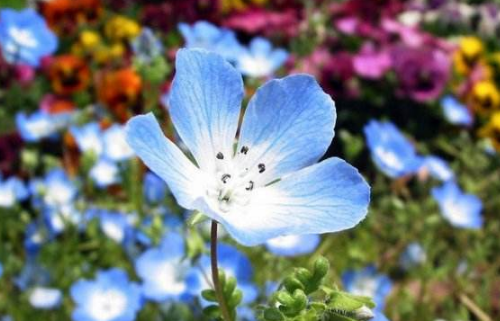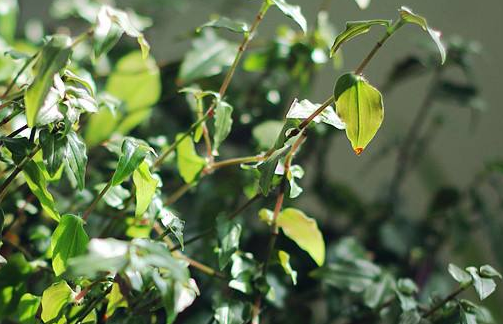Culture methods of Iris
1. Soil
Iris is suitable to grow in slightly alkaline soil rich in humus and good drainage; some peat, vermiculite and fine sand can be added to the heavy soil to improve the soil.

two。 Temperature
The most suitable temperature for Iris is 16-18 ℃, the lowest soil temperature should be more than 5 ℃, and the highest temperature should not exceed 20 ℃. Too high temperature will wither the flowers.
3. Drainage condition
Iris needs a good drainage system to make full use of water and reduce the problem of salt accumulation caused by water.
4. Fertilizer application
Generally, do not apply base fertilizer before planting, it will slow down the root growth of the plant, and phosphate fertilizer and triphosphate fertilizer can not be used.
5. Seed bulb storage
The temperature of the bulb should be stored at 30 ℃, and the seed medicine of the cut flower should be planted immediately. The temperature should be suitable for bulb growth, which should be kept at about 2 ℃. If the temperature is higher than 2 ℃, the treatment time will be prolonged, which is disadvantageous to flowering. To maintain a suitable temperature, we should also maintain good air permeability, and the bulbs should not be stored for a long time.
Culture methods of Iris
The breeding method of Iris: Iris can be propagated after flowering in spring or autumn, and it can be planted once after 2-4 years. When dividing the rhizome, note that each piece should have 2-3 adventitious buds, and the wound should be planted after being embalmed with plant ash or sulfur powder.
Sowing and propagation: the seeds should be sown immediately after maturation, and it takes 2 to 3 years for seedlings to blossom. The planting distance is 40-50 cm and the planting depth is 7-8 cm. It can also be promoted by cultivation.
Cultivation and management: grow in humus-rich loam and grow poorly in acidic soil. Before cultivation, rotten compost should be fully applied, and bone powder and plant ash should be used as base fertilizer. The application of chemical fertilizer and organic liquid fertilizer during the growing period can make the plant strong and leafy.
>, viewing and application
Iris is large and beautiful, such as a kite like a butterfly, its leaves are green and green, like a sword, and its ornamental value is very small, so it can be regarded as a worldwide flower. The English and Latin names of Iris are Alice, which means rainbow flower. Gu'ai and others believe that iris is a symbol of "power". The Yugoslav people think that Iris is a noble god. Iris is the national flower of France. It has been painted with irises since the 12th century on the Fujian emblem of France. Legend has it that when Clowe, the king of the first dynasty in France, was baptized, God gave him a gift, irises. Iris is a symbol of light and freedom. The name of this plant comes from the messenger of God and the rainbow that connects the earth to other worlds. Another legend is that the rainbow saved the life of King Frank in the 6th century. when he saw the rainbow rising from the Rhine, he knew that the river was shallow enough that he crossed the river to escape from the enemy. As a result, Iris is highly respected and regarded as the national flower.
Iris has long been planted in the Central Plains and the Yangtze River Basin in China, and it is no stranger to flower lovers. Iris is often used to symbolize love and friendship in our country. It has a bright future.
Iris leaves green and green, flowers are large and strange, just like Pianpian butterfly, is one of the important flowers in the garden. Iris is a beautiful potted flower, cut flower and flower bed flower. In recent years, with the construction of the ecological environment of urban lakes and wetlands, irises are planted in wet places, and the poolside lakeside is very suitable. Whenever the green kite tail blossoms into purple-blue butterfly-shaped flowers in early summer in May, it seems to be dancing to add color to the lake. If planted with a mixture of blue, blue-purple and white iris, it can increase the appearance.
The culture method of Iris must look at the maintenance method.
Iris flowers are large and strangely shaped, like butterflies, the leaves are green and green, and they have high ornamental value. Many people will choose potted irises to be arranged in the middle of their homes. The following editors will take you to learn about the breeding methods of irises:
The basic information of Iris:
Iris tectorum (Latin name: Iris), also known as purple butterfly, blue butterfly, black kite, flat bamboo flower, Phalaenopsis and so on, is a kind of flower native to central China, and now it is mainly distributed in the central and southern part of China. Its flower shape is large and beautiful, and most of the colors are blue-purple, which can be watched. Its rhizome can be used as traditional Chinese medicine, can be collected all the year round, and has anti-inflammatory effect.
Iris culture methods:
1. Soil: clay soil that is moderately moist, well drained, rich in humus and slightly alkaline.
2. Watering: watering depends on the situation, watering once a week during the growth period of open field cultivation, and the amount of watering decreases gradually with the decrease of air temperature. it is generally advisable for the soil to be slightly dry, and do not make the soil stagnant or too wet for a long time, so as not to cause rotten roots or diseases.
3. Sunshine: Iris is full of sunlight and slightly resistant to shade. It can be cultivated in open field. Strong adaptability, general normal management will be able to grow vigorously.
4. Fertilization: base fertilizer can be applied before planting, once a year in autumn, and chemical fertilizer can be applied in the growing period.
5. Insect pests: the common diseases of iris are rust, soft rot and so on. The rust can be controlled with 400 times of 25% trimethoprim at the initial stage, and the soft rot can be controlled with Bordeaux solution of 1 ril and 100%. The insect pest has eroded night moth, which can be irrigated with 1200 times solution of trichlorfon.
Most of the irises are blue-purple, and the flowers are shaped like butterflies, which looks like a butterfly flying in a green film, which is very good-looking. The breeding methods of irises are introduced here. I believe you also have a certain understanding of the conservation of irises. You can try to plant irises in the area to decorate your home.
- Prev

Culture methods of Chrysanthemum morifolium
Humidity management likes higher air humidity, and too low air humidity will accelerate the withering of a single flower. Also afraid of rain, need to keep the leaves dry at night, the optimum air relative humidity is 65-75%. Temperature management likes warm climate, avoids extreme heat, and obviously grows poorly when the summer temperature is higher than 34 ℃. It is not resistant to frost.
- Next

Hydroponic culture of wedding dress hanging orchid
1. Choose a container because it is hydroponic, so the choice of container should be more strict. Although any container that can hold water is OK, it is best to choose a transparent container. What are the advantages of this? First of all, a transparent container can make it easier for us to better observe its root growth.
Related
- Fuxing push coffee new agricultural production and marketing class: lack of small-scale processing plants
- Jujube rice field leisure farm deep ploughing Yilan for five years to create a space for organic food and play
- Nongyu Farm-A trial of organic papaya for brave women with advanced technology
- Four points for attention in the prevention and control of diseases and insect pests of edible fungi
- How to add nutrient solution to Edible Fungi
- Is there any good way to control edible fungus mites?
- Open Inoculation Technology of Edible Fungi
- Is there any clever way to use fertilizer for edible fungus in winter?
- What agents are used to kill the pathogens of edible fungi in the mushroom shed?
- Rapid drying of Edible Fungi

